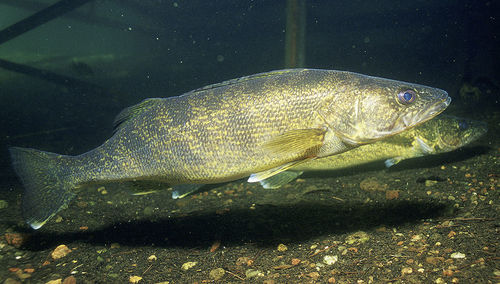
Walleye
The Atlantic bluefin tuna (Thunnus thynnus) is a highly migratory, large pelagic fish renowned for its size, speed, and commercial value. It's a top predator in the marine ecosystem and plays a crucial role in maintaining balance. Sadly, this magnificent species faces significant threats.
10 29 years
Lifespan
80 cm
Length
Least Concern
Conservation Status
20 km/h
Swimming speed
Carnivorous, Insectivorous
Diet
Local Migration
Migration
Appearance Overview
The Atlantic bluefin tuna is a large, streamlined fish with a metallic blue body and a silvery underside.
Coloration
Dark metallic blue above, silvery white below
Fins
Two dorsal fins, the first depressible; small finlets running from dorsal and anal fins to the tail
Body Shape
Torpedo-shaped, built for speed and endurance
Length
Up to 13 feet (4 meters)
Weight
Up to 2,000 lbs (907 kg)
Diet
Carnivorous, feeding on a variety of fish, squid, crustaceans, and eels.
Feeding Behavior
Highly active predator, using speed and agility to hunt. They can hunt individually or cooperatively, sometimes herding prey.
Social Behavior
Forms schools, especially when young. Schools can be segregated by size. Known for long migrations.
Commercial Relevance
Extremely high value, especially in the Japanese sushi and sashimi market. This demand drives high prices and contributes to overfishing.
Conservation measures
Subject to international fishing quotas and regulations managed by organizations like ICCAT. Marine Protected Areas and fishing gear restrictions are also in place.
Status
Endangered (IUCN)
Threats
Overfishing (historically and currently the biggest threat), bycatch in fishing gear, climate change impacting prey distribution.
Habitat Distribution
Depth Range
0-1,000 meters (typically in the upper layers of the ocean)
Geographic Range
Atlantic Ocean, Mediterranean Sea, Gulf of Mexico
Preferred Environment
Temperate and subtropical waters; open ocean (pelagic) and coastal areas
Reproduction and Life Cycle
Breeding Habits
Spawns in warm waters, primarily in the Mediterranean Sea and the Gulf of Mexico. Spawning occurs in specific areas and times.
Development Stages
Eggs hatch into larvae, which develop rapidly in plankton-rich waters. Juveniles grow quickly, forming schools.
Fecundity
Females can release up to 30 million eggs per spawning season.
Maturity Age
Matures relatively late, around 4-8 years in the Mediterranean and 8-12 years in the Western Atlantic.
Faqs about Walleye
How long do Atlantic bluefin tuna live?
Atlantic bluefin tuna can live up to 40 years, though this is becoming rarer due to fishing pressure.
How fast can bluefin tuna swim?
They are among the fastest fish in the ocean, capable of bursts of speed up to 40-60 mph.
Are bluefin tuna warm-blooded?
Yes, they are warm-blooded, which allows them to maintain a higher body temperature than the surrounding water, aiding in muscle efficiency.
Why are bluefin tuna endangered?
Overfishing has severely depleted populations, leading to strict regulations and conservation efforts.
Where are Atlantic bluefin tuna found?
They are primarily found in the Atlantic Ocean, ranging from the Mediterranean Sea to the Gulf of Mexico and the coasts of North America and Europe.
What do Atlantic Bluefin Tuna eat?
They consume a wide range of prey including smaller fish like herring and mackerel, as well as squid, crustaceans, and eels.
Copyright @ Nature Style Limited. All Rights Reserved.
 English
English